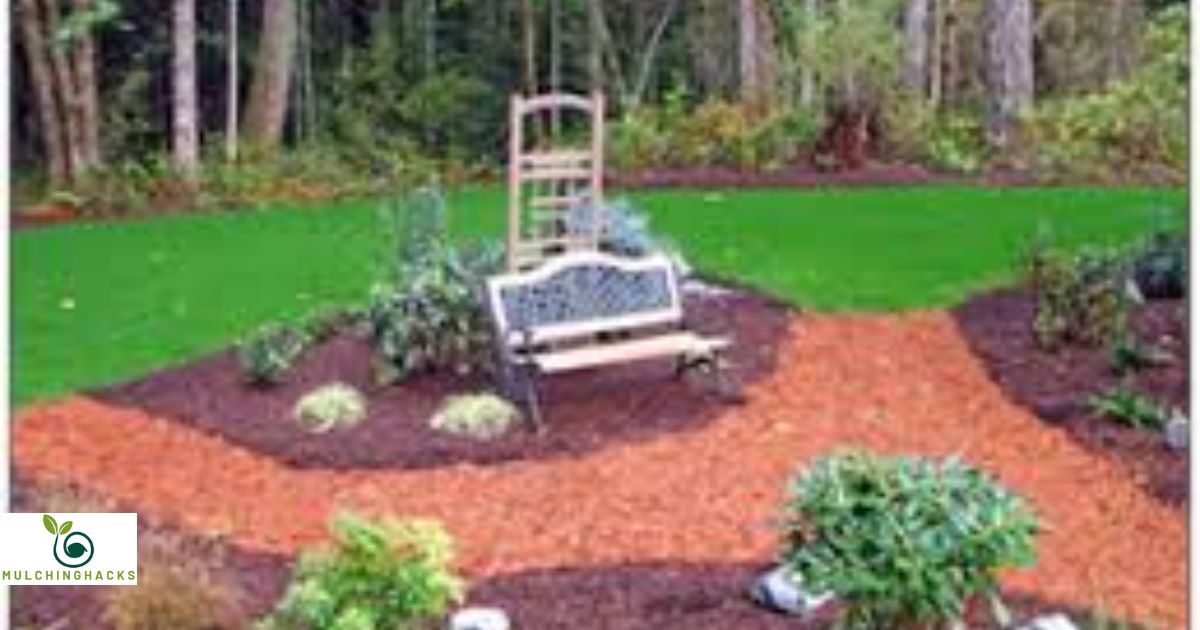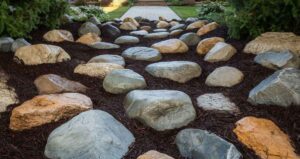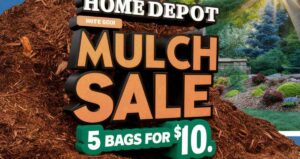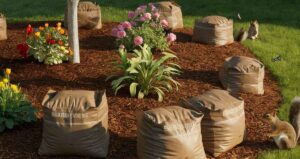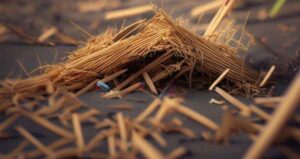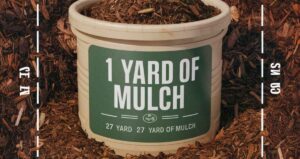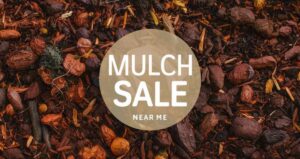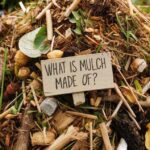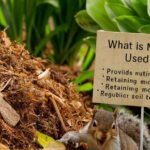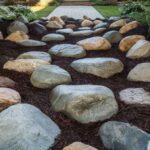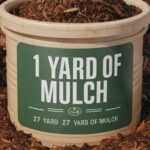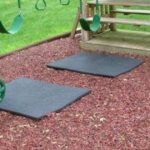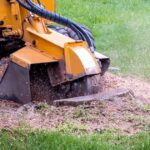Pine needles, also known as pine straw, are a common sight in many parts of the world, especially in areas with pine trees. These needles often fall to the ground, creating a blanket of organic material. While some people may view them as a nuisance to be raked up and disposed of, others recognize the potential benefits of pine needles as mulch. In this comprehensive guide, we will explore the use of pine needles as mulch and answer the question: Can pine needles be used as mulch?
Here’s a simple table outlining the usage of pine needles as mulch
| Can Pine Needles Be Used as Mulch? | Yes |
| Benefits | – Moisture retention |
| – Weed control | |
| – Soil temperature regulation | |
| – Aesthetic appeal | |
| – Slightly acidic nature beneficial for certain plants | |
| Considerations | – Best suited for plants that prefer acidic soil |
| – Slower decomposition rate compared to some other mulch materials | |
| – Most practical in areas with an abundance of pine trees | |
| – May require periodic replenishment as it decomposes |
What is Mulch?
Mulch is a protective covering, typically made of organic or inorganic materials, that is spread over the soil’s surface in gardens and around plants. Mulch serves several important purposes in gardening, including conserving moisture, controlling weed growth, regulating soil temperature, and enhancing the overall aesthetics of a garden.
Types of Mulch
There are various types of mulch, including organic mulch (e.g., wood chips, compost, leaves) and inorganic mulch (e.g., gravel, landscape fabric). In this article, we will focus on organic mulch, specifically pine needle mulch.
Pine Needles as Mulch
Advantages of Pine Needle Mulch
Pine needle mulch offers several advantages that make it a popular choice among gardeners:
Moisture Retention
Pine needles form a loose, airy mulch layer that allows water to penetrate easily.
They also reduce moisture evaporation from the soil surface, helping to keep the soil consistently moist.
Weed Control
The dense layer of pine needles acts as a natural weed barrier, preventing weed growth by blocking sunlight.
Soil Temperature Regulation
Pine straw helps regulate soil temperature by keeping it cooler in the summer and warmer in the winter.
Aesthetic Appeal
Many gardeners appreciate the rustic and natural appearance of pine needle mulch.
pH Level Maintenance:
Pine needles have a slightly acidic nature, which can benefit plants that thrive in lower-pH soil conditions.
Considerations Before Using Pine Needles

Before applying pine needle mulch, consider the following
Acidic Soil Preferences
While pine needles can help lower soil pH, they are best suited for plants that prefer acidic soil conditions, such as azaleas, blueberries, and rhododendrons.
Decomposition Rate
Pine needles decompose more slowly than some other mulch materials. This means you won’t need to replace them as frequently.
Abundance of Pine Trees
Using pine needles as mulch is more practical in areas with an abundance of pine trees, where needles are readily available.
How to Use Pine Needles as Mulch
Preparing Your Garden Bed
Before applying pine needle mulch, prepare your garden bed as follows:
Weed Removal:
Clear the area of existing weeds and debris to ensure that the mulch is effective in preventing weed growth.
Soil Preparation:
Ensure your soil is adequately moist and fertilized to provide a suitable environment for your plants.
Applying Pine Needle Mulch
The application of pine needle mulch is straightforward:
Layer Thickness
Apply a layer of pine needles that is approximately 2 to 3 inches deep. This thickness provides effective weed control and moisture retention.
Mulch Depth Maintenance
Periodically check the mulch depth to ensure it remains at the desired level. You may need to add more mulch as it decomposes.
Caring for Your Pine Needle Mulch
Mulch Thickness
Maintaining the proper thickness of your pine needle mulch is essential. This layer should be thick enough to suppress weeds and conserve moisture but not so thick that it hinders water penetration. As the mulch decomposes, periodically replenish it to maintain the desired depth.
Refreshing Your Mulch
Over time, pine needle mulch will break down and decompose. When it starts to look thin or compacted, or if you notice weed growth, it’s time to refresh your mulch layer. Simply add a new layer of pine needles on top of the existing mulch to restore its effectiveness.
Pine Needle Mulch Myths
Acidifying Soil
One common myth associated with pine needle mulch is that it significantly acidifies the soil. While pine needles are slightly acidic, their impact on soil pH is relatively modest and typically temporary. For plants that require highly acidic soil conditions, additional amendments may be necessary.
Repelling Insects
Another myth is that pine needle mulch acts as a natural insect repellent. While some insects may be deterred by the texture and acidity of pine needles, it is not a foolproof method of insect control. For effective pest management, consider other strategies and treatments as needed.
FAQ
Can I use pine needles as mulch in a vegetable garden?
Yes, you can use pine needles as mulch in a vegetable garden. They work well for vegetables like tomatoes and peppers that thrive in slightly acidic soil conditions. However, be cautious with certain root vegetables and adjust the pH if needed.
Do pine needles attract any specific pests or wildlife?
Pine needles are generally not a magnet for pests, but they can create a habitat for small insects and spiders. Additionally, some birds may use pine needles for nesting material. Overall, the presence of pine needles is not a significant factor in attracting unwanted pests.
Can I use pine needles as mulch around acid-sensitive plants?
It’s important to be cautious when using pine needle mulch around acid-sensitive plants, such as hydrangeas or azaleas. While pine needles can acidify the soil, the impact may not be sufficient for these plants. Consider other acidic amendments if you have specific acid-sensitive plants in your garden.
How frequently should I replenish or replace pine needle mulch?
Pine needle mulch decomposes slowly, so you won’t need to replenish it as often as some other mulch materials. However, it’s a good practice to add a new layer
of pine needles every 1-2 years to maintain the desired thickness and effectiveness.
Can I use pine needles as mulch in regions without pine trees?
Pine needles are most readily available in regions with pine trees. If you live in an area without pine trees, using pine needles as mulch may be less practical due to limited access. In such regions, it’s advisable to explore alternative mulch materials that are locally abundant.
Conclusion
Pine needles can indeed be used as mulch, and they offer various benefits in gardening, such as moisture retention, weed control, and soil temperature regulation. However, their suitability depends on your location, the type of plants you’re growing, and your preference for a slightly acidic pH in the soil.
When using pine needle mulch, it’s important to maintain the proper layer thickness, refresh it as needed, and be aware of the myths surrounding its effects on soil pH and insect control. Sustainable gardening practices, including the use of pine needle mulch, can enhance the health and vitality of your garden while reducing maintenance and conserving resources. So, if you have an abundance of pine needles at your disposal, consider giving pine needle mulch a try and enjoy the benefits it can bring to your garden.
